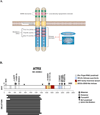Neuroblastoma: developmental biology, cancer genomics and immunotherapy
- PMID: 23702928
- PMCID: PMC4386662
- DOI: 10.1038/nrc3526
Neuroblastoma: developmental biology, cancer genomics and immunotherapy
Abstract
Neuroblastoma is a solid tumour that arises from the developing sympathetic nervous system. Over the past decade, our understanding of this disease has advanced tremendously. The future challenge is to apply the knowledge gained to developing risk-based therapies and, ultimately, improving outcome. In this Review we discuss the key discoveries in the developmental biology, molecular genetics and immunology of neuroblastoma, as well as new translational tools for bringing these promising scientific advances into the clinic.
Conflict of interest statement
MSKCC has a patent application on hu3F8 and NKC was named as one of the inventors. MSKCC has licensed the patent on beta-glucan to Biotec Pharmacon, and the patent on antibody 8H9 to United Therapeutics, and NKC was named as one of the inventors for both agents. Clinical trials of hu3F8 are funded by the NCI (NKC) and the DOD (NKC).
Figures



References
Publication types
MeSH terms
Substances
Grants and funding
- CA161978/CA/NCI NIH HHS/United States
- R01 EY018599/EY/NEI NIH HHS/United States
- HHMI/Howard Hughes Medical Institute/United States
- R01 EY023619/EY/NEI NIH HHS/United States
- R01 CA168875/CA/NCI NIH HHS/United States
- R01 CA154754/CA/NCI NIH HHS/United States
- P30 CA021765/CA/NCI NIH HHS/United States
- EY018599/EY/NEI NIH HHS/United States
- EY014867/EY/NEI NIH HHS/United States
- CA154754/CA/NCI NIH HHS/United States
- R21 CA161978/CA/NCI NIH HHS/United States
- CA168875/CA/NCI NIH HHS/United States
- CA21765/CA/NCI NIH HHS/United States
- R01 EY014867/EY/NEI NIH HHS/United States
LinkOut - more resources
Full Text Sources
Other Literature Sources
Medical
Molecular Biology Databases
Miscellaneous

